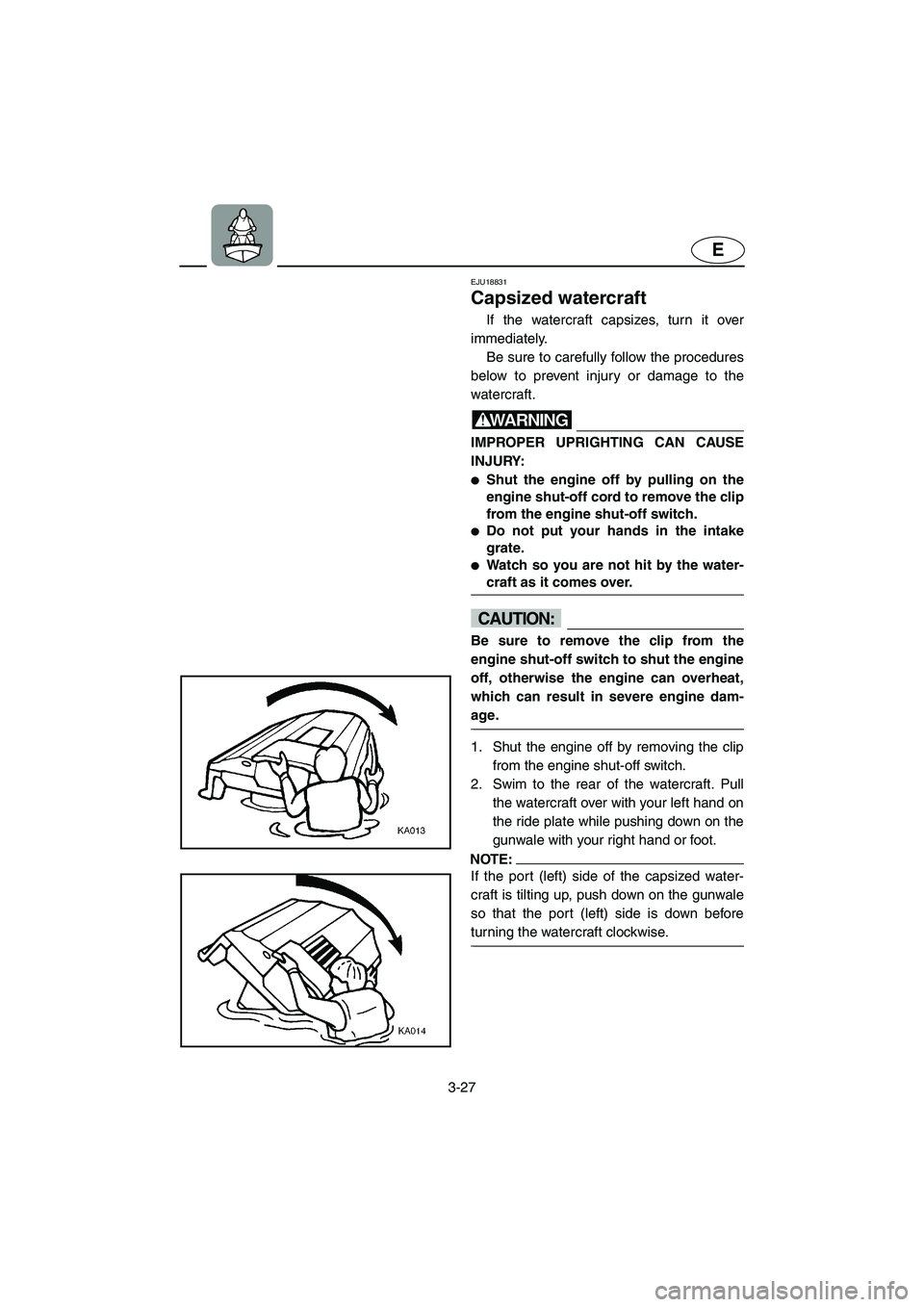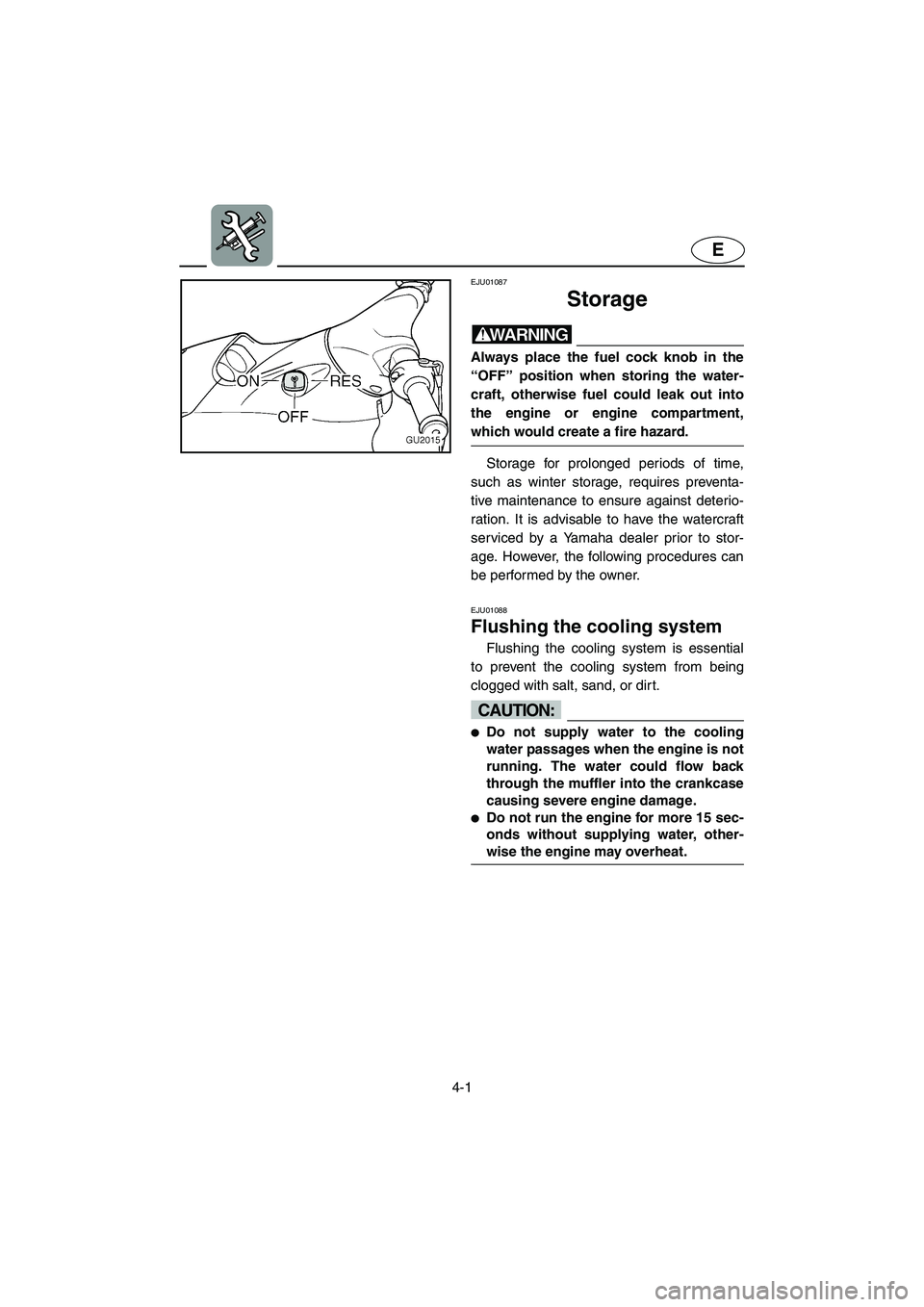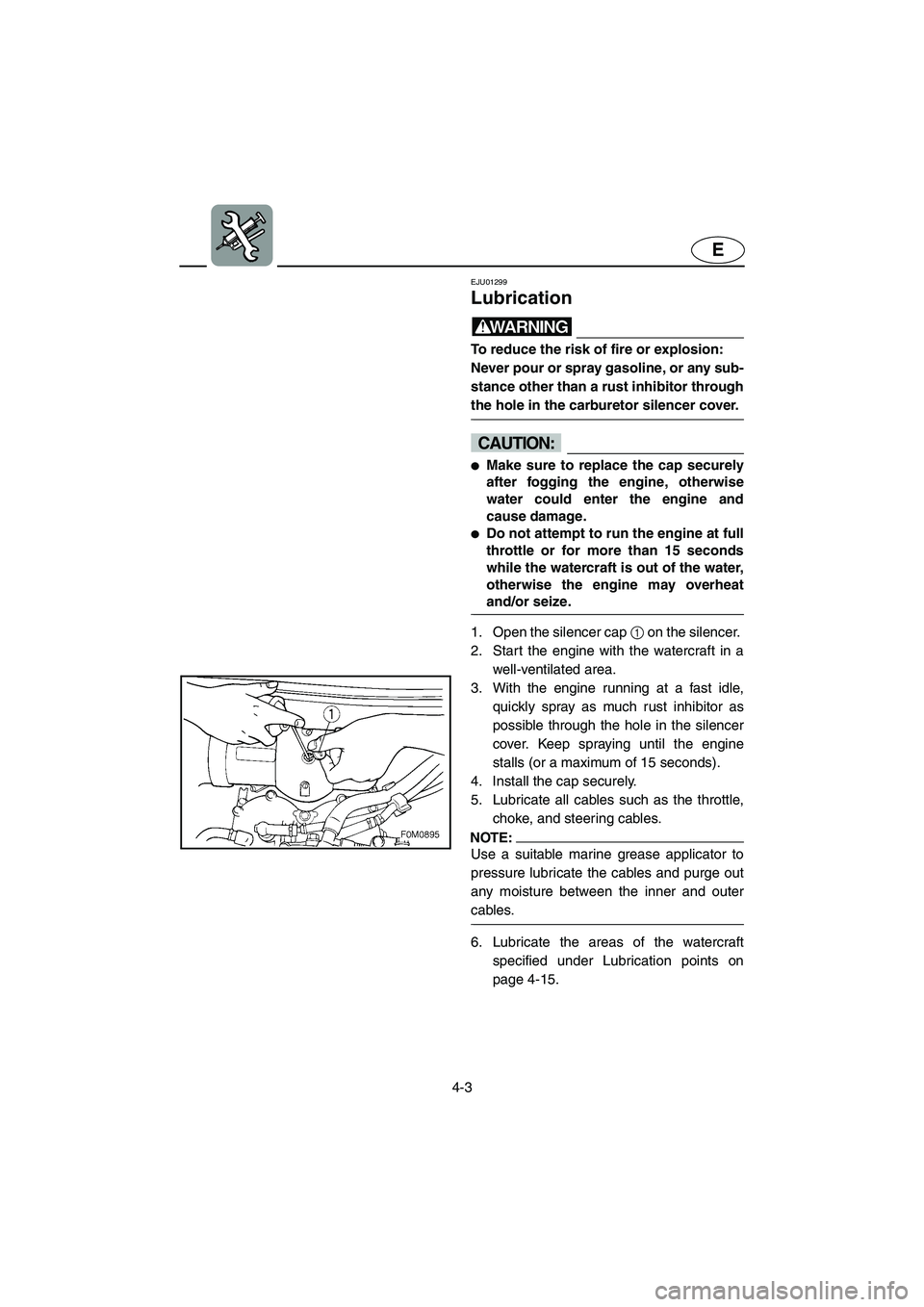Page 25 of 120

E
2
EJU01007
FEATURES AND
FUNCTIONS
Location of main components .............. 2-1
Operation of controls and other
functions ................................................... 2-4
Rear seat ................................................ 2-4
Front seat ............................................... 2-5
Hood ....................................................... 2-6
Fuel tank filler cap .................................. 2-7
Oil tank filler cap ..................................... 2-7
Fuel cock knob ....................................... 2-8
Engine stop switch ................................. 2-9
Engine shut-off switch ............................ 2-9
Choke knob ............................................ 2-9
Throttle lever ........................................ 2-10
Start switch ........................................... 2-10
Cooling water pilot outlet ..................... 2-11
Steering system ................................... 2-11
Handgrip ............................................... 2-12
Finger grip ............................................ 2-12
Engine overheat warning system ........ 2-13
Oil level warning lamp .......................... 2-14
Storage compartments ........................ 2-15
UF0M75.book Page 1 Thursday, May 29, 2003 9:53 AM
Page 38 of 120
2-13
E
EJU01131
Engine overheat warning
system
This model is equipped with an engine
overheat warning system.
If the engine starts to overheat, the
engine speed will be limited to about
3,400 r/min.
When this occurs, check for water dis-
charge at the cooling water pilot outlet. If
there is no discharge of water, reduce the
engine speed and beach the watercraft, and
then check the intake grate and impeller for
clogging.
WARNING@ Before attempting to remove weeds or
debris from the intake grate or impeller,
shut the engine off and remove the clip
from the engine shut-off switch. Severe
injury or death could result from coming
in contact with the rotating parts of the
jet pump.
@
CAUTION:@ If you cannot locate and correct the
cause of the overheating, consult a
Yamaha dealer. Continuing to operate at
higher speeds could result in severe
engine damage.
@
UF0M75.book Page 13 Thursday, May 29, 2003 9:53 AM
Page 55 of 120

3-12
E
EJU01058
Jet unit
Carefully check the jet intake for weeds,
debris, or anything else that might restrict
the intake of water. If the intake is clogged,
cavitation could occur, reducing jet thrust,
and possibly damaging the jet pump.
In some cases, the engine may overheat
because of lack of cooling water, and dam-
age to the engine could result. Engine cool-
ing water is fed to the engine by the jet
pump. (See page 5-4 for jet intake cleaning
procedures.)
WARNING@ �Keep away from intake grate while
engine is on. Items such as long hair,
loose clothing, or PFD straps can
become entangled in moving parts
resulting in severe injury or drowning.
�Stop the engine and remove the clip
from the engine shut-off switch before
removing any debris or weeds, which
may have collected around the jet
intake.
@
EJU01059
Engine shut-off cord (lanyard)
Check that the engine shut-off cord is not
frayed or broken. If the cord is damaged,
replace it; never try to repair it or tie it
together.
UF0M75.book Page 12 Thursday, May 29, 2003 9:53 AM
Page 56 of 120
3-13
E
EJU18351
Switches
CAUTION:@ Do not run the engine for more than
15 seconds on land without supplying
water. The engine can overheat.
@
Check the start switch, the engine stop
switch, and the engine shut-off switch for
proper operation.
Push the start switch 1 to start the
engine. As soon as the engine starts run-
ning, push the engine stop switch 2 to ver-
ify that the engine stops immediately.
Restart the engine, and then pull the engine
shut-off cord 5 to remove the clip 4 from
the engine shut-off switch 3 to verify that
the engine stops immediately. (See pages
2-9 to 2-10 for information on proper opera-
tion of the start switch, the engine stop
switch, and the engine shut-off switch.)
EJU01320
Cooling water pilot outlet
Check that water comes out from the out-
let while the engine is running and the
watercraft is in the water.
UF0M75.book Page 13 Thursday, May 29, 2003 9:53 AM
Page 70 of 120

3-27
E
EJU18831
Capsized watercraft
If the watercraft capsizes, turn it over
immediately.
Be sure to carefully follow the procedures
below to prevent injury or damage to the
watercraft.
WARNING@ IMPROPER UPRIGHTING CAN CAUSE
INJURY:
�Shut the engine off by pulling on the
engine shut-off cord to remove the clip
from the engine shut-off switch.
�Do not put your hands in the intake
grate.
�Watch so you are not hit by the water-
craft as it comes over.
@
CAUTION:@ Be sure to remove the clip from the
engine shut-off switch to shut the engine
off, otherwise the engine can overheat,
which can result in severe engine dam-
age.
@
1. Shut the engine off by removing the clip
from the engine shut-off switch.
2. Swim to the rear of the watercraft. Pull
the watercraft over with your left hand on
the ride plate while pushing down on the
gunwale with your right hand or foot.
NOTE:@ If the port (left) side of the capsized water-
craft is tilting up, push down on the gunwale
so that the port (left) side is down before
turning the watercraft clockwise.
@
UF0M75.book Page 27 Thursday, May 29, 2003 9:53 AM
Page 77 of 120

3-34
E
EJU01084
Post-operation checks
Always perform the following post-opera-
tion checks after operating the watercraft.
1. Remove the watercraft from the water.
2. Wash down the hull, handlebars, and jet
unit with fresh water.
3. Remove the seat and check the engine
compartment for water. To drain excess
water, remove the stern drain plugs, then
raise the bow of the watercraft enough to
allow water in the bilge to drain out.
NOTE:@ This watercraft is equipped with an auto-
matic bilge-draining system that removes
water from the engine compartment while
you are underway. However, some residual
water will remain.
@
4. Put the watercraft in a horizontal posi-
tion.
5. Flush the cooling system to prevent it
from clogging with salt, sand, or dirt.
(See page 4-1 for flushing the cooling
system procedures.)
6. Drain residual water from the exhaust
system by alternately squeezing and
releasing the throttle lever for 10 to
15 seconds while the engine is running.
CAUTION:@ Do not attempt to run the engine at full
throttle or for more than 15 seconds
while the watercraft is out of the water,
otherwise the engine may overheat or
seize.
@
UF0M75.book Page 34 Thursday, May 29, 2003 9:53 AM
Page 82 of 120

4-1
E
EJU01087
Storage
WARNING@ Always place the fuel cock knob in the
“OFF” position when storing the water-
craft, otherwise fuel could leak out into
the engine or engine compartment,
which would create a fire hazard.
@
Storage for prolonged periods of time,
such as winter storage, requires preventa-
tive maintenance to ensure against deterio-
ration. It is advisable to have the watercraft
serviced by a Yamaha dealer prior to stor-
age. However, the following procedures can
be performed by the owner.
EJU01088
Flushing the cooling system
Flushing the cooling system is essential
to prevent the cooling system from being
clogged with salt, sand, or dirt.
CAUTION:@ �Do not supply water to the cooling
water passages when the engine is not
running. The water could flow back
through the muffler into the crankcase
causing severe engine damage.
�Do not run the engine for more 15 sec-
onds without supplying water, other-
wise the engine may overheat.
@
UF0M75.book Page 1 Thursday, May 29, 2003 9:53 AM
Page 84 of 120

4-3
E
EJU01299
Lubrication
WARNING@ To reduce the risk of fire or explosion:
Never pour or spray gasoline, or any sub-
stance other than a rust inhibitor through
the hole in the carburetor silencer cover.
@
CAUTION:@ �Make sure to replace the cap securely
after fogging the engine, otherwise
water could enter the engine and
cause damage.
�Do not attempt to run the engine at full
throttle or for more than 15 seconds
while the watercraft is out of the water,
otherwise the engine may overheat
and/or seize.
@
1. Open the silencer cap 1 on the silencer.
2. Start the engine with the watercraft in a
well-ventilated area.
3. With the engine running at a fast idle,
quickly spray as much rust inhibitor as
possible through the hole in the silencer
cover. Keep spraying until the engine
stalls (or a maximum of 15 seconds).
4. Install the cap securely.
5. Lubricate all cables such as the throttle,
choke, and steering cables.
NOTE:@ Use a suitable marine grease applicator to
pressure lubricate the cables and purge out
any moisture between the inner and outer
cables.
@
6. Lubricate the areas of the watercraft
specified under Lubrication points on
page 4-15.
UF0M75.book Page 3 Thursday, May 29, 2003 9:53 AM